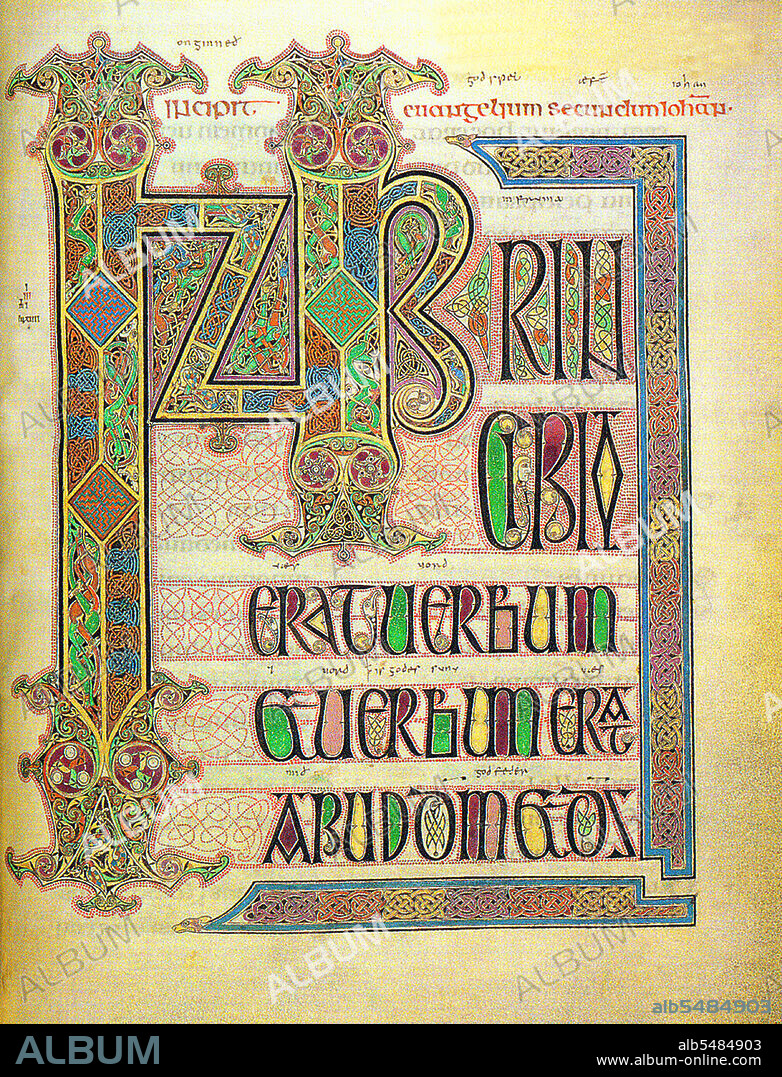alb5484903
The Lindisfarne Gospels, Lindisfarne (Holy Island), c. 700 CE. Folio 211 recto, the incipit from the Gospel of St John.

|
Añadir a otro lightbox |
|
Añadir a otro lightbox |



¿Ya tienes cuenta? Iniciar sesión
¿No tienes cuenta? Regístrate
Compra esta imagen.
Selecciona el uso:

Título:
The Lindisfarne Gospels, Lindisfarne (Holy Island), c. 700 CE. Folio 211 recto, the incipit from the Gospel of St John.
Descripción:
Traducción automática: Los Evangelios de Lindisfarne es un libro de evangelios manuscrito iluminado producido alrededor del año 700 d.C. en un monasterio en la isla de Lindisfarne, frente a la costa de Northumberland. Ahora se exhibe en la Biblioteca Británica de Londres. El manuscrito es una de las mejores obras del estilo único del arte hibernosajón o insular, que combina elementos mediterráneos, anglosajones y celtas. Se presume que los Evangelios de Lindisfarne son obra de un monje llamado Eadfrith, que se convirtió en obispo de Lindisfarne en 698 y murió en 721. Los estudios actuales indican una fecha alrededor de 715, y se cree que fueron escritos en honor a San Cuthbert. Sin embargo, también es posible que Eadfrith los haya producido antes de 698, para conmemorar la elevación de las reliquias de Cuthbert en ese año, que también se cree que fue la ocasión para la cual se produjo el Evangelio de San Cuthbert. Los Evangelios están ricamente ilustrados en estilo insular y originalmente estaban encerrados en una fina encuadernación de cuero cubierta con joyas y metales hecha por Billfrith el Anacoreta en el siglo VIII. Sin embargo, durante las incursiones vikingas en Lindisfarne, esta portada se perdió y se hizo una reemplazo en 1852. El texto está escrito en escritura insular. En el siglo X se hizo una traducción de los Evangelios al inglés antiguo: una glosa palabra por palabra insertada entre líneas del texto latino por Aldred, preboste de Chester-le-Street. Esta es la traducción más antigua que existe de los Evangelios al idioma inglés. Es posible que los Evangelios hayan sido extraídos de la catedral de Durham durante la disolución de los monasterios, ordenada por Enrique VIII, y fueron adquiridos a principios del siglo XVII por Sir Robert Cotton a Thomas Walker, secretario de los parlamentos. La biblioteca de Cotton llegó al Museo Británico en el siglo XVIII, y de allí a la Biblioteca Británica de Londres cuando ésta se separó del Museo Británico.
The Lindisfarne Gospels is an illuminated manuscript gospel book produced around the year 700 CE in a monastery on Lindisfarne Island, off the coast of Northumberland. It is now on display in the British Library in London. The manuscript is one of the finest works in the unique style of Hiberno-Saxon or Insular art, combining Mediterranean, Anglo-Saxon and Celtic elements. The Lindisfarne Gospels are presumed to be the work of a monk named Eadfrith, who became Bishop of Lindisfarne in 698 and died in 721. Current scholarship indicates a date around 715, and it is believed they were produced in honour of St. Cuthbert. However, it is also possible that Eadfrith produced them prior to 698, in order to commemorate the elevation of Cuthbert's relics in that year, which is also thought to have been the occasion for which the St Cuthbert Gospel was produced. The Gospels are richly illustrated in the insular style, and were originally encased in a fine leather binding covered with jewels and metals made by Billfrith the Anchorite in the 8th century. During the Viking raids on Lindisfarne, however, this cover was lost, and a replacement was made in 1852. The text is written in insular script. In the 10th century an Old English translation of the Gospels was made: a word-for-word gloss inserted between the lines of the Latin text by Aldred, Provost of Chester-le-Street. This is the oldest extant translation of the Gospels into the English language. The Gospels may have been taken from Durham Cathedral during the Dissolution of the Monasteries, ordered by Henry VIII, and were acquired in the early 17th century by Sir Robert Cotton from Thomas Walker, Clerk of the Parliaments. Cotton's library came to the British Museum in the 18th century, and from there to the British Library in London when this was separated from the British Museum.
Crédito:
Album / Pictures From History/Universal Images Group
Autorizaciones:
Tamaño imagen:
3600 x 4717 px | 48.6 MB
Tamaño impresión:
30.5 x 39.9 cm | 12.0 x 15.7 in (300 dpi)
Palabras clave:
ANGLOSAJON • ANTIGUO TESTAMENTO • ART • ARTE • ARTES • BIBLIA • BIBLICA • BÍBLICO • BÍBLICOS • BRITANICO • BRITANICOS • CALIGRAFIA • CELTA • CELTAS • CHRISTIAN • CHRISTIANITY • CRISTIANA • CRISTIANAS • CRISTIANDAD • CRISTIANISMO • CRISTIANO • CRISTIANOS • CRISTIANSMO • CRISTO • ESCRITURA • GRAN BRETAÑA • HISTORIA • HISTORICO • INGLATERRA • INGLES • INGLESA • INGLESES • JESUS • LIBROS • NUEVO TESTAMENTO • PINTURA • REINO UNIDO • RELIGION • RELIGION: CRISTIANA • SAN CUTHBERT • VIEJO TESTAMENTO


 Pinterest
Pinterest Twitter
Twitter Facebook
Facebook Copiar enlace
Copiar enlace Email
Email
